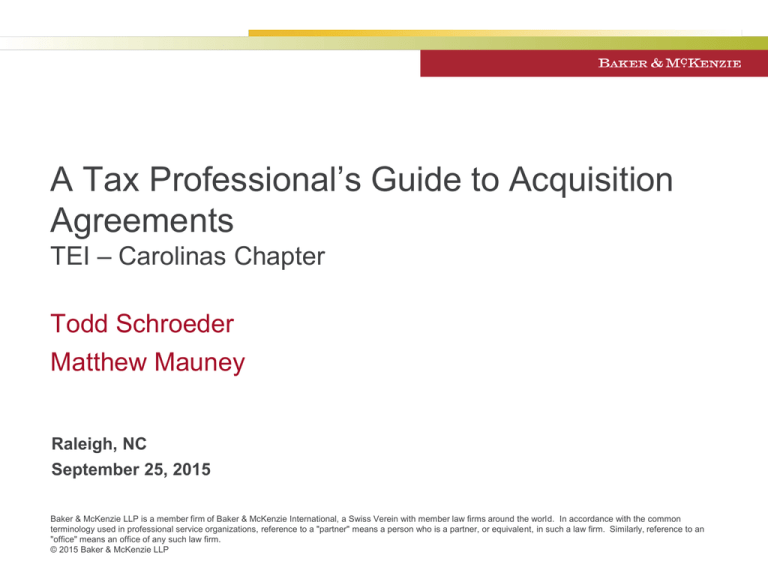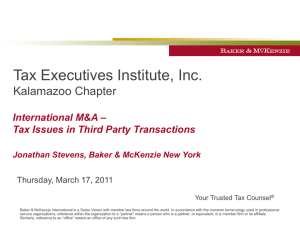Raleigh TEI (Sept 2015) - A Tax Professionals Guide to Acquisition
advertisement

A Tax Professional’s Guide to Acquisition Agreements TEI – Carolinas Chapter Todd Schroeder Matthew Mauney Raleigh, NC September 25, 2015 Baker & McKenzie LLP is a member firm of Baker & McKenzie International, a Swiss Verein with member law firms around the world. In accordance with the common terminology used in professional service organizations, reference to a "partner" means a person who is a partner, or equivalent, in such a law firm. Similarly, reference to an "office" means an office of any such law firm. © 2015 Baker & McKenzie LLP Agenda – Crafting Acquisition Agreements – Tax Representations and Due Diligence – FIRPTA – Tax Compliance and Tax Costs – Tax Treatment Indemnity Payments – Escrow Considerations – Transaction Expenses ©2015 Baker & McKenzie 2 Crafting Acquisition Agreements ©2012 Baker & McKenzie 3 General items to consider - Seller – What type of process is the sale process? – Auction – Strategic disposition – Anti-trust – Is tax-free transaction available? – Stock sale v. asset sale? – Who is the Buyer? – Competitor – Private equity – Are we the target? ©2015 Baker & McKenzie 4 General items to consider - Buyer – What type of transaction is it? – Auction – Strategic disposition – Anti-trust – Stock sale v. asset sale – Who is the Seller? – Competitor – Private equity – Is the target a widely held company? – Impact of stock option expense deductions ©2015 Baker & McKenzie 5 Stock vs. Asset Transactions Taxable Stock Acquisition Taxable Asset Acquisition • • Buyer gets FMV tax basis in assets • Target’s NOLs not available to Buyer • • No carryover of tax methods • No transfer of historic liabilities to Buyer • Increases structuring flexibility • Usually a double level of tax for • corporate Seller and its shareholders • Generally Buyer’s preference Buyer gets carryover tax basis in assets Tax attributes (including NOLs) generally carryover, subject to limitations • Usually single level of tax for Seller unless Target is a sub of consolidated group • Historic liabilities of Target transfer to Buyer • Generally an individual Seller’s preference (if transaction is not tax free) Section 338 Election: Step-up in basis of assets but NOLs not available (distributed to Seller under Section 381) ©2015 Baker & McKenzie 6 Tax Representations and Due Diligence ©2012 Baker & McKenzie 7 Role of tax representations – Role of tax representations can vary depending on type of transaction – Generally 3 primary purposes – Due diligence – Indemnity – Walk away rights ©2015 Baker & McKenzie 8 Tax representations – Issues to consider – Survival periods – Disclosures for exceptions to representations – Stock sales v. assets sales – Public v. private transactions – Representations in other sections that could impact tax ©2015 Baker & McKenzie 9 Tax Due Diligence – Seller Due Diligence – Identify what will be sold – Quantify cost of sale – Confirm possible indemnification risks – Determine historic exposures remaining with Seller – Identify transfer tax costs of transaction ©2015 Baker & McKenzie 10 Tax Due Diligence – Buyer Due Diligence – Identify possible tax exposures that Buyer could be responsible for after closing. – Timing of due diligence – Pre-Signing v. Pre-Closing – Quantify the impact of possible limitations of postclosing use of attributes/incentives – Consider post-acquisition integration plan – Identify transfer tax costs of transaction – Confirm whether withholding applies to purchase ©2015 Baker & McKenzie 11 FIRPTA ©2012 Baker & McKenzie 12 FIRPTA – Applies to all sales of real property located in the United States – Applies to the sale of a domestic corporation if the target owns a significant amount of U.S. real property, in terms of asset fair market values – Purchaser must withhold 10% of the consideration unless an exception applies, e.g., receipt of withholding certificates – Certificate of non-foreign status or non-USRPI Certificate ©2015 Baker & McKenzie 13 Tax Compliance and Tax Costs ©2012 Baker & McKenzie 14 Tax Compliance – Tax return preparation – Direct taxes – Indirect taxes – Straddle period taxes – Tax audits – Amended tax returns ©2015 Baker & McKenzie 15 Tax Costs – Purchase price allocation – Covenants not to compete – Tax indemnification – Withholding taxes – Transfer taxes – Caps and deductibles – Purchaser tax acts – Current and deferred tax liabilities ©2015 Baker & McKenzie 16 Tax Treatment of Indemnity Payments ©2012 Baker & McKenzie 17 Tax Treatment of Indemnity Payments – Applies to all indemnity payments, not just tax – Computational approaches – Purchase price adjustment – Gross-up for taxes – Tax-effected ©2015 Baker & McKenzie 18 Escrow Considerations ©2012 Baker & McKenzie 19 Who Owns the Escrowed Property? – What is the contingency? – Separate tax escrow? – Which party is entitled to income earned on the escrowed proceeds? – Which entity is allocated the annual tax liability? – Installment sale implications ©2015 Baker & McKenzie 20 Transaction Expenses ©2012 Baker & McKenzie 21 Buyer Expenses – Generally, costs incurred in a taxable acquisition are capitalized into the acquired stock or assets – capitalized costs include those paid on or after the earlier of: (1) delivery of LOI, offer letter or other similar proposal; or (2) board approval of the acquisition – expenses incurred before that time still must be capitalized if they are “inherently facilitative,” e.g., valuation of target, negotiations, or structuring – If the acquisition fails, the costs are recoverable ©2015 Baker & McKenzie 22 Seller Expenses – Does the expense create a benefit beyond one year or create a separate asset? – Costs to fend of hostile acquisitions should be deductible – Break-up fees should be deductible – Cash settlement of employee stock rights should be deductible as compensation – Constructive dividend to shareholders when paid as part of a stock acquisition? – 70% deductibility safe harbor for success-based fees ©2015 Baker & McKenzie 23 Thank You Baker & McKenzie International is a Swiss Verein with member law firms around the world. In accordance with the common terminology used in professional service organizations, reference within the organization to a “partner” means a person who is a partner, or equivalent, in a member firm or its affiliate. Similarly, reference to an “office” means an office of any such law firm. ©2015 Baker & McKenzie 24






